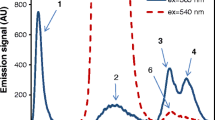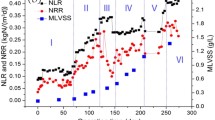Abstract
The on-line sensing of viable cell weight in plant cell culture process is applied to analysis and control of process. The fiber-optic fluorescence sensor was constructed to measure the NADH-dependent fluorescence inNicotiana tabacum plant cell culture and the analysis of fluorescence signal was done to be correlated with the viable cell weight. The structured kinetic model for cell growth was proposed to estimate the theoretical viable cell weight. The dimensional analysis was proposed for the interpretation of fluorescence signal, in which the path length, the inner filter effect and the hydrodynamic conditions were considered as the key factors on fluorescence signal. The dimensional analysis and empirical correlation of fluorescence signal to viable cell weight was applied to the interpretation of the detected fluorescence signal during cultivation. The proposed interpretation of fluorescence signal using dimensional analysis was well correlated with the viable cell weight estimated by the structured kinetic model as well as by empirical correlation.
Similar content being viewed by others
References
Abolel-Latif, M. S. and Guidbault, G. G.,“Fiber Optic Based Biosensors Utilizing Immobilized Enzyme Systems”, Biosensor Technology: Fundamentals and Applications, Buck, R. P., Hatfield, W. E., Umana, M. and Bowden, E. F., eds., Marcel Dekker, New York, 1990.
Anders, K. D. and Müller, W., Scheper, T. and Bückmann, A. F., “Use of Fluorescence Sensors: I. For the Monitoring of Immobilized Cell Culture Fluorescence II. As Optical Biosensors”, Biochemical Engineering VI, Goldstein, W., DiBiasico, D. and Pedersen, H., eds., New York Academy of Science, New York, 1990.
Baeyens, W., De Keukeleire, D. and Korkidis, K., “Luminescence Techniques in Chemical and Biochemical Analysis”, Marcel Dekker, Inc., New York, 1991.
Coppella, S. J. and Rao, G.,“Practical Considerations in the Measurement of Culture Fluorescence”,Biotechnol. Prog.,6, (1990).
Dixon, R. A.,“Isolation and Maintenance of Callus and Cell Suspension Cultures”, Plant Cell Culture: A Practical Approach, Dixon, R. A., ed., IRL Press, Oxford, 1986.
Duysens, L. N. M. and Amesz, J., “Fluorescence Spectrometry of Reduced Phosphopyridine Nucleotide in Intact cells in the Near-Ultraviolet and Visible Region”,Biochim. Biophys. Acta,24, 19(1957).
Groom, C. A., Luong, J. H. T. and Mulchandani, A., “On-Line Culture Fluorescence Measurement During the Batch Fermentation of Poly-\-hydroxybutyrate ProducingAlcaligenes eutrophus”,J. Biotechnol.,8, 271 (1988).
Humphrey, A. E., Brown, K., Horvath, J. and Semerjian, H.,“The Use of Fluorometry in Monitoring and Control of Cell Cultures”, Bioproducts and Bioprocesses, Fiechter, A., Okada, H. and Tanner, R. D., eds., Springer-Verlag, Berlin, 1989.
Junker, B. H., Wang, D. I. C. and Hatton, T. A., “Fluorescence Sensing of Fermentation Parameters Using Fiber Optics”,Biotechnol. and Bioeng.,32, 55 (1988).
Li, J. K. and Humphrey, A. E., “Kinetic and Fluometric Behavior of a Phenol Fermentation”,Biotechnol. Lett.,11, 177(1989).
Li, J. K., Asali, E. C., Humphrey, A. E. and Horvath, J. J., “Monitoring Cell Concentration and Activity by Multiple Excitation Fluorometry”,Biotechnol. Prog.,7, 21 (1991).
Metzler, C.M., Elfring, G.L. and McEwen, A.J., “A Package of Computer Programs for Pharmacokinetic Modeling”,Biometrics,30, 562 (1974).
Meyer, C. and Beyeler, W., “Control Strategies for Continuous Bioprocess Based on Biological Activities”,Biotechnol. Bioeng.,26, 916 (1984).
Moser, A., “Bioprocess Technology; Kinetics and Reactors”, Springer-Verlag, New York, 1988.
Peck, M. W. and Chynoweth, D. P., “On-Line Monitoring of the Methanogenic Fermentation by Measurement of Cell Culture Fluorescence”,Biotechnol. Letters,12, 17(1990).
Reardon, K. F., Scheper, T. and Bailey, J. E., “Metabolic Pathway Rates and Culture Fluorescence in Batch Fermentations ofClostridium acetobutylicum”,Biotechnol. Prog.,3, 153(1987).
Reardon, K. F. and Bailey, J. E., “Metabolic Pathway Rates and Fluorescence Measurement During Bioconversions by Non-Growing ImmobilizedClostridium acetobutylicum”,Biotechnol. Prog,5, 144(1989).
Ristroph, D. L., Watteeuw, G. M. W., Armiger, B. and Humphrey, A. E., “Experience in the Use of Culture Fluorescence for Monitoring Culture Fluorescence”,J. Ferment. Technol.,55, 599 (1977).
Walker, C. C. and Dhurjati, P., “Use of Culture Fluorescence as a Sensor for On-Line Discrimination of Host and Overproducing RecombinantEscherichia coli”,Biotechnol. Bioeng.,33, 500(1989).
Wang, N. S. and Simmons, M. B., “Fluorescence Modeling in a Multicomponent System”,Biotechnol. and Bioeng.,38, 1292 (1991).
Author information
Authors and Affiliations
Rights and permissions
About this article
Cite this article
Choi, JW., Park, J.H., Lee, S.C. et al. Analysis of culture fluorescence by a fiber-optic sensor inNicotiana tabacum plant cell culture. Korean J. Chem. Eng. 12, 528–534 (1995). https://doi.org/10.1007/BF02705855
Received:
Accepted:
Issue Date:
DOI: https://doi.org/10.1007/BF02705855




